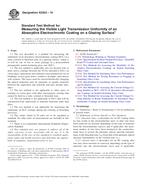Wir benötigen Ihre Einwilligung zur Verwendung der einzelnen Daten, damit Sie unter anderem Informationen zu Ihren Interessen einsehen können. Klicken Sie auf "OK", um Ihre Zustimmung zu erteilen.
ASTM E2354-10
Standard Guide for Assessing the Durability of Absorptive Electrochromic Coatings within Sealed Insulating Glass Units (Withdrawn 2019)
Automatische name übersetzung:
Standard-Handbuch für die Bewertung der Dauerhaftigkeit der Absorptionselektrochrome Beschichtungen innerhalb Sealed Isolierglas
NORM herausgegeben am 1.10.2010
Informationen über die Norm:
Bezeichnung normen: ASTM E2354-10
Anmerkung: UNGÜLTIG
Ausgabedatum normen: 1.10.2010
SKU: NS-45113
Zahl der Seiten: 5
Gewicht ca.: 15 g (0.03 Pfund)
Land: Amerikanische technische Norm
Kategorie: Technische Normen ASTM
Kategorie - ähnliche Normen:
Die Annotation des Normtextes ASTM E2354-10 :
Keywords:
chromogenic glazing, durability, electrochromic windows, fenestration, insulating glass units, sealed insulating glass units, Building constructions/materials--railings, Building materials performance, Railing systems (glass), ICS Number Code 25.220.40 (Metallic coatings)
Ergänzende Informationen
| Significance and Use | ||||||||||||||||
|
This guide provides a recommended systematic sequence for using the referenced test methods for evaluating the durability of EC insulating glass units (IGUs) as described in section 1.2. , (See Appendix X1, Section X1.4.) This guide provides a summary of the durability issues addressed by each of the series of standards that are necessary for assesing the durability of electrochromic coatings (ECCs) in insulating glass units (IGUs). When fully implemented in buildings in the U.S., ECCs in IGUs have the potential of significantly reducing our current energy consumption for all uses-not just buildings. IGUs with ECCs will, of necessity, have to be able to pass the applicable standards listed in Appendix X1, Section X1.4, as well as an ASTM standard on wind loading for IGUs. Passing these will not be sufficient because the operating temperatures of ECCs in IGUs can potentially be as high as 90°C at the center-of glass, whereas the highest temperature used in Test Method E2188 is 60°C . Listings of existing and proposed standards are given in Table 1 and in Appendix X1, Section X1.4. |
||||||||||||||||
| 1. Scope | ||||||||||||||||
|
1.1 This guide provides the recommended sequence for using the referenced ASTM test methods for assessing the durability of absorptive electrochromic coatings (ECCs) within sealed insulating glass units. Cross sections of typical electrochromic glazings have three to five-layers of coatings that include one to three active layers sandwiched between two transparent conducting electrodes (TCOs, see Section 3). Examples of the cross-sectional arrangements can be found in “Evaluation Criteria and Test Methods for Electrochromic Windows.” (For a list of acronyms used in this standard, see Appendix X1, Section X1.1). 1.2 This guide is applicable only for layered (one or more active coatings between the TCOs) absorptive ECCs on vision glass (superstrate and substrate) areas planned for use in IGUs for buildings, such as glass doors, windows, skylights, and exterior wall systems. The layers used for electrochromically changing the optical properties may be inorganic or organic materials between the superstrate and substrate. 1.3 The ECCs used in this guide will ultimately be exposed (Test Method E2141) to solar radiation and deployed to control the amount of radiation by absorption and reflection and thus, limit the solar heat gain and amount of solar radiation that is transmitted into the building. 1.4 This guide is not applicable to other types of coatings on vision glass with other chromogenic coatings, for example, photochromic and thermochromic coatings. 1.5 This guide is not applicable to IGUs that will be constructed from superstrate or substrate materials other than glass. 1.6 The test methods referenced in this guide are laboratory test methods conducted under specified conditions. 1.7 The values stated in SI units are to be regarded as standard. No other units of measurement are included in this standard. 1.8 There is no comparable International Standards Organization Standard. 1.9 This standard does not purport to address all of the safety concerns, if any, associated with its use. It is the responsibility of the user of this standard to establish appropriate safety and health practices and determine the applicability of regulatory requirements prior to use. |
||||||||||||||||
| 2. Referenced Documents | ||||||||||||||||
|
Ähnliche Normen:
Historisch
1.6.2010
Historisch
1.11.2011
Historisch
15.6.2014
Historisch
1.6.2012
Historisch
1.4.2012
Historisch
1.10.2010
Empfehlungen:
Aktualisierung der technischen Normen
Wollen Sie sich sicher sein, dass Sie nur die gültigen technischen Normen verwenden?
Wir bieten Ihnen eine Lösung, die Ihnen eine Monatsübersicht über die Aktualität der von Ihnen angewandten Normen sicher stellt.
Brauchen Sie mehr Informationen? Sehen Sie sich diese Seite an.



 ASTM D4584-05(2010)..
ASTM D4584-05(2010).. ASTM D6492-99(2011)..
ASTM D6492-99(2011).. ASTM D7639-10(2014)..
ASTM D7639-10(2014).. ASTM D7803-12
ASTM D7803-12 ASTM E1659-12
ASTM E1659-12 ASTM E2355-10
ASTM E2355-10
 Cookies
Cookies
